How to Train Your Dragon
 for sequences of intense action and some scary images, and brief mild language.
for sequences of intense action and some scary images, and brief mild language.
Reviewed by: Angela Bowman
CONTRIBUTOR
| Moral Rating: | Better than Average |
| Moviemaking Quality: |
|
| Primary Audience: | Kids Teens Family |
| Genre: | 3D Animation Fantasy Comedy Kids Family IMAX |
| Length: | 1 hr. 38 min. |
| Year of Release: | 2010 |
| USA Release: |
March 26, 2010 (wide—3,000+ theaters) DVD: October 15, 2010 |


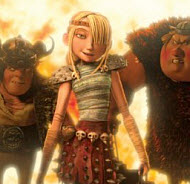
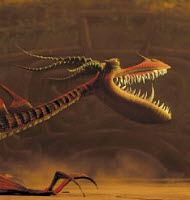
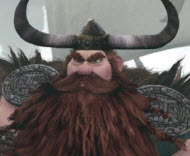
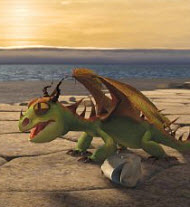
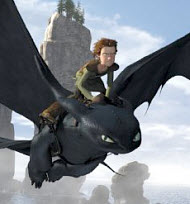
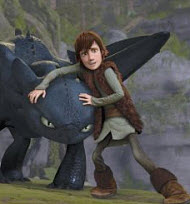
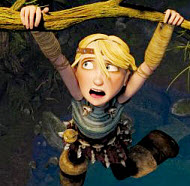
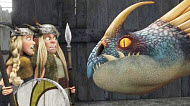

Dragons and dinosaurs—discover how they are connected
Dragons in the Bible
Are dinosaurs mentioned in the BIBLE? Answer
| Featuring |
|---|
|
voices of… Jay Baruchel (Hiccup) Gerard Butler (Stoick) America Ferrera (Astrid) Jonah Hill (Snotlout) Kristen Wiig (Ruffnut) Christopher Mintz-Plasse (Fishlegs) David Tennant (Spitelout) See all » |
| Director |
|
Dean DeBlois Chris Sanders |
| Producer |
|
DreamWorks Animation Mad Hatter Entertainment See all » |
| Distributor |
Based on the 2004 book by Cressida Cowell, “How To Train Your Dragon” drops us into a Viking community which is and appears to have always been at war with a horde of dragons. Life in this village centers around this war, and fear and hatred for dragons is promoted for survival.
As with most communities, however, there is one unlike the rest, Hiccup (voiced by Jay Baruchel), the peculiar son of the tribe chief, Stoick the Vast (Gerard Butler), is always out of sync, in the way, and a great disappointment and embarrassment to his father and the rest of the village.
After befriending a rare dragon Hiccup names “Toothless,” he starts to realize who he is as he finds his place in the world while discovering that reality is much different from the assumptions of his people. Eventually he must present this truth to others, even though he knows how much it will hurt his father, who doesn’t understand or listen to him to begin with.
I found “How To Train Your Dragon” to be charmingly endearing. While initially frightful, Toothless turns out to be as a beloved pet, much like one of my dogs with the appearance of a cat. And likewise, the first scene is dark and foreboding, but we find that the negative beliefs of the people have shaped an attitude that has caused this darkness in which they live and with positive change light rises over the course of the film.
“… on those living in the land of the shadow of death a light has dawned.” (Matt 4:16)
Other life lessons, including loyalty and teamwork, importance of community and family are poignantly presented (Phil 2:3 Do nothing out of selfish ambition or vain conceit, but in humility consider others better than yourselves.), and I much appreciated that the relationship between father and son was given highest importance and respect. I am reminded that even though our Earthly fathers may fail us, we have God our Father who never will never leave us nor forsake us (Deu. 31:6), who delights in us (Prov. 3:12 and Psa 147:11) and cherishes our oddities, as He made us each unique (Psa. 139:13-14).
Negative Content
There is quite a bit of violence and violent speech which may frighten younger viewers, note that while technically violent, it is not gory. Various types of dragons burning down villages, snatching sheep, fighting, cartoonish pictures of cut off heads, lost limbs (not graphic), regurgitated, half-eaten fish and quite a bit of dialogue about killing, including various ways dragons kill people and people kill dragons, an instance where Hiccup says he is going to cut out a dragon’s heart and take it to his father and Astrid, offended by a boy, hits him over the head with a shield and tells him that it now has blood on it. Skulls adorn some clothing. There are a couple of references to Norse gods, including “the gods hate me,” but the subject is not pursued. The dragon is referred to as “devil” (in a general sense, not as the actual devil).
In one scene Astrid lands on top of Hiccup and a comment is made about “love on the battlefield.” There are two scenes of kissing, one on the cheek and one on the lips. Hiccup is given a helmet which turns out to be half of his late mother’s breastplate, the other half used as a helmet for his father. Hiccup thanks his father for the “breast hat.”
Language is mainly restricted to name calling, such as “son of a half-troll,” one instance of h*ll and b*tt.
Positive Content
Hiccup eventually learns to be true to himself, even knowing he stands alone. He builds confidence as he learns and then applies his knowledge. Despite feeling helpless at times and at times making the wrong decisions, he always tries to do what is right. He and Toothless are loyal friends, displaying not only teamwork, but the necessity of it and our dependence on one another. Commitment to and importance of community is also apparent. His relationship with his father is most important, and it is mainly out of honor and love for his father that his bad decisions, secretive actions stem. Reconciliation and forgiveness wrap up this tale with classic warm and fuzziness.
Violence: Heavy / Profanity: Minor / Sex/Nudity: Minor
Dragons and dinosaurs—discover how they are connected
See list of Relevant Issues—questions-and-answers.


To start, I would like to say that I loved this movie! I had the thrill of seeing this movie in Real-D 3D, which was amazing and made it that much more enjoyable. The plot was well done and the movie was relatively clean, with no foul language or sexual content. However, as a Viking movie, there were many references to Norse gods (Odin, Thor), instead of the one true God, Jesus Christ. The movie might be a little violent for some with the dragons blowing fire and the final battle at the end.
Except for that, I would recommend this movie to anyone. Just be sure you explain to your kids about Norse mythology and that they understand what they are viewing and hearing.
Moral rating: Better than Average / Moviemaking quality: 5
Moral rating: Better than Average / Moviemaking quality: 4
Moral rating: Better than Average / Moviemaking quality: 4
If I hadn’t already prepared him, I’d say this movie is for the 6 and older crowd. The only things that were slightly offensive were already mentioned in the above review (like the “breast helmet”).
Overall, great family film with a great message. When you have faith you’re doing the right thing, you can’t let anyone or anything stand in your way… even a parent. I think Matthew 10:34-39 goes well with the theme of this movie.
Moral rating: Better than Average / Moviemaking quality: 4½
Moral rating: Excellent! / Moviemaking quality: 4½
Yes, there were references to Norse gods, and there were a few very slight instances of bad language (like the love on a battlefield line), but, overall, this movie was far better than most of the movies that come out these days. While it didn’t glorify God, it didn’t mock him or our values, either. That is no small feat for Hollywood. The story of loyalty to your family and loyalty to your friends was a valuable one.
The movie itself was fast-paced, and the quality was excellent. I would recommend it to Christians who aren’t upset by the thought of dragons being our friends.
Moral rating: Good / Moviemaking quality: 4½
Overall, we very much enjoyed the movie, as did our children. Some of the humor between Hiccup and the other young vikings is teenage in nature, but, of course, passed right over our children’s heads. As the reviewer noted, there is very brief reference to Norse gods, but it is very brief and doesn’t dwell on them in any way. Overall, we thoroughly enjoyed the movie, and it is definitely one that we will add to our Blu-Ray collection when it is available.
Moral rating: Excellent! / Moviemaking quality: 5
Moral rating: Better than Average / Moviemaking quality: 5
Moral rating: Good / Moviemaking quality: 4½
I base my rating of “better than average” on the display of massive “protective” tiki torches surrounding the island, in conversation Astrid and Hiccup refer to the Vikings “Gods”, and when Astrid and Hiccup are taken to the “Dragons Nest” by Toothless, all of the dragons and paying “offerings” of food to a massive dragon.
Overall, I believe this movie is family friendly a word of caution for those with children 6-, a massive dragon lives in the “dragons nest” and in this scene swallows a small dragon whole, this scene really upset my child because the dragon is small enough that is looks as if it were a baby dragon.
Moral rating: Better than Average / Moviemaking quality: 5
A) Hiccup and his father don’t see eye to eye with each other, Hiccup deciding he doesn’t want to fight dragons while his father says that he should attend to dragon fighting as soon as possible in the training arena. His father doesn’t understand his son and vice versa because both have a hard time telling each other what is important to one another. This is especially true when Hiccup feels he couldn’t explain to his dad, much less his acquaintances in the village, about his growing friendship with a night fury dragon named Toothless. It is only when his father and the other vikings are in true peril of losing their lives that Hiccup proves to his father how much he cares for him, regardless of the arguments they have had with one another. His father also realizes how hard-hearted he had been towards his son, finally listening to him and seeing what an honorable young man his son is.
B) The relationship between Toothless and Hiccup was probably one of my favorite aspects of this movie. Toothless speaks volumes of emotion through his eyes, body movement, and mouth without saying a word. Unlike many dragons, Hiccup discovers that he is different from the others. Night furies are known to kill their victims but this one decides to let Hiccup live, as a result of Hiccup freeing him after he captured him the night before. Their growth of trust and dependence on one another is brilliantly executed throughout each scene when they are together. Little by little, the dragon learns to overcome its own doubts and misconceptions of humans, accepting Hiccup and allowing him to help him recover from his injuries. Hiccup and Toothless share a bond with each other that is precious and proves itself to be a lasting one in the end no matter what the cost may be for either of them.
C)This is not just your usual fairy tale where you have mythological creatures and heroes to fight them. Both dragons and vikings have seen each other as enemies for several hundreds of years and neither has wanted to understand the other. Hiccup is truly the first viking of his kind who gets a unique opportunity to see through a dragon’s perspective, just as Toothless is the first of his kind to see that not all humans are without compassion. This is definitely not a safe world that Hiccup lives in. There are intense moments when there is the possibility he or any of his family and friends may not survive. There is also beauty and wonder to behold for Hiccup as he becomes inseparable with Toothless, learning to fly on the back of a dragon. There were definitely scenes in this film that had me tearing up because of the amazing writing and thought that was put into this movie.
In the spirit of “Kung Fu Panda” and “Madagascar 2,” I can say that Dreamworks is definitely heading down the right path. I hope you’ll find as much enjoyment as I did with “How to Train Your Dragon.”
Moral rating: Good / Moviemaking quality: 5
Moral rating: Better than Average / Moviemaking quality: 5
Moral rating: Good / Moviemaking quality: 5
Moral rating: Better than Average / Moviemaking quality: 4
I found this movie to be a fun and enjoyable movie for my whole family. It was a good story and had many good messages. But is was also fun, toothless was the cutest! Reminded me of my cat! If you have a young child (5 or under)who is easily scared, this might have scary scenes for them. But if you let your kids watch disney movies then this movie has much less objectionable content! I recommend it for the whole family! My husband and I enjoyed it as much as our 7 year old daughter!
Moral rating: Better than Average / Moviemaking quality: 4½
Moral rating: Good / Moviemaking quality: 5
2) Astrid has a scene just after Hiccup’s father (and everyone else) sail off to destroy the dragons where she shows a beautiful and powerful femininity. The Christian church has a reputation for training women to be second class citizens, but I want both my sons and my daughters to grow up to fully fill the measure that God has made them to be. I love her insight, her open-ness, and the kind of relational courage that it takes to have a conversation like that.
This is the best movie I have seen in a long time. I think that my daughter will be richer from watching it 12 times in a row than she would by watching “Finding Nemo” or “Shrek” or any of a dozen… modern movies that do not enrich the soul.
I would like to warn anyone who read the book, that this movie is nothing like the book. The facts that they are Vikings, on an Island, Hiccup befriends a dragon, and they fight a large dragon in the end are about the only similarities. However, I like the movie story better than the book. I wish the book had the movie plot instead.
Moral rating: Good / Moviemaking quality: 4
Yes, there were references to viking gods but they were vikings so I went in knowing this would happen anyway. The bond between Toothless and Hiccup is very convincing and also beautiful in that they’re two friends who truly trust and depend on each other. As it says in the Bible, if one falls the other is there to pick him up. Toothless also reminded me of my Rottweiler mix and how loyal a dog/horse/cat can become. Seeing it in 3D or without, this movie is a winner. (and at one point it almost moved me to tears) It isn’t without it’s flaws, mention of the breastplate joke and other subtle references, but it’s worth it.
Plus, the aerial shots are so breathtaking in 3D it felt like flying.
Moral rating: Good / Moviemaking quality: 5
Moral rating: Better than Average / Moviemaking quality: 5
There are a couple references made about Norse gods, a comment made about the helmet given to Hiccup, and a kissing scene (very brief) between Hiccup and Astrid. Overall, the movie had a good theme going… standing out for what is right is more honorable than following the crowd. All the other Norsemen wanted to kill the dragons, but Hiccup was the one who stood out and defended the dragons. We as Christians are told, by the Scriptures, to stand out, separate from the world. The Bible tells us we may live in this world but that we are not to be OF this world.
So, overall, was it a good film? Sort of. Again, it wasn’t Dreamworks best, nor was it there worst. However, on a positive note the 3D was good so if you’re going to see this movie, I highly recommend seeing it in Digital 3D. I would recommend this movie to children 10 and older, however, because of the violence.
Moral rating: Better than Average / Moviemaking quality: 3½
Overall, this film isn’t as offensive as it could have been. The fighting wasn’t gory or extremely violent (although there are images on tapestries and in a book showing decapitated men with blood coming from their necks, and dragons with swords through their stomachs, but not in graphic detail). The fight scene at the end of the movie is probably too frightening for young children, so I don’t recommend taking kids under 7 or 8 to watch this.
The little sexuality seemed fine to me (average boy-crushes-on-girl scenario, and ***SPOILER*** Astrid eventually likes Hiccup and kisses him as well. However, the second time she kisses him is slightly more intense than the first.
***END SPOILER***
One of the Viking twins flirts with Hiccup in a seductive tone, and there is the mention of Hiccup and Stoic’s helmets being made out of the breastplate of Hiccup’s mother.
I’m not entirely sure if this movie is something Christians should watch. It’s not the worst in terms of morals, (there are good lessons of forgiveness, humbling yourself and admitting you’re wrong, defending the wronged), but I don’t feel it’s glorifying to God, especially with the spiritual aspect of the film. It isn’t focused on, it’s just a small part of the dialogue, but we have to be careful of what we allow in our hearts and minds.
Moral rating: Average / Moviemaking quality: 3½
It then devolves further with an underdog character who needs to prove himself, a cool girl he aspires to know better, dumb adults locked into an obsolete mind set that the hero has to challenge, and a father who he has to get to know better by doing everything differently. Let me be clear—there’s nothing very wrong with “How to Train Your Dragon,” in fact, it’s a well realized story, but its utterly predictable.
The message (of reaching out and understanding rather than hating and fighting) is hackneyed and unoriginal. OK its a message that bears repeating, but surely there has got to be better ways of doing it. If I had to sum up this film in one word, it would be “bland”. And we know what the bible says about lukewarm, don’t we? I don’t think I wasted my time seeing this, but I won’t be watching it again. And I think I’ll pass on any sequel too.
Moral rating: Better than Average / Moviemaking quality: 3
Aside from that and the one comment about Hiccup’s helmet having been forged from his (deceased?) mother’s breastplate (why do kids' films these days almost always lack one parent?), it’s a fun movie. In fact, we may even see it again since my husband wasn’t with us, and we may have a day in town soon with some time to kill and may take him to see it—just for the fun of the 3D imagery going over those rocky cliffs and, of course, the dragons.
Moral rating: Better than Average / Moviemaking quality: 4
Moral rating: Offensive / Moviemaking quality: 5
The only negative thing I have about the movie was the use of words like hell, and they said the Lord’s name in vain once, which was offensive in that way. They also had a kiss on the cheek and on the lips, which I find inappropriate, because they are 12 yr. old children kissing. Also, Hiccup’s dad gave Hiccup a helmet, which he referred to as his mother’s breastplate, which I didn’t like because this was supposed to be a kid’s movie, but, overall, I enjoyed this film.
Moral rating: Better than Average / Moviemaking quality: 4½
***SPOILER ALERT*** Some scenes may be scary for younger viewers. Some of the dragons, especially the big, bad dragon (the only real “bad” dragon for that matter) and some of the others are downright frightening. All the dragons have many sharp, pointed teeth (Toothless' are retracted most of the movie, thus his name) and at the beginning there’s an opening sequence of many swooping down and snatching helpless sheep. A fiery battle ensues. No blood is shown. The bad dragon eats both a dragon (taking a snap at Toothless) and the sheep, amongst fish and such. Speaking of fish, on two occasions Toothless regurgitates a piece of fish in an attempt to share it with Hiccup. The final battle takes place in the sky and ends with the bigger “bad” dragon literally burning from the inside out (nothing it shown) and Hiccup looses a foot (also, nothing shown). Astrid and Hiccup kiss, but nothing actually sexual happens.
***END OF SPOILER***
Other than that, Dreamworks was able to treat me and my family, and many other families across the US with a warm-'n-fuzzy movie that’ll make you proud to take your kids to! Hope this review helped!!!…
Moral rating: Better than Average / Moviemaking quality: 5
Moral rating: Good / Moviemaking quality: 4½
I was never bored, and I loved the adorable little dragon’s and the funny dragon “Toothless” who was obviously not toothless! I loved this movie, and so did my mom and dad, my 15 year old sister and her friends! I highly suggest this movie.
Moral rating: Excellent! / Moviemaking quality: 4
Moral rating: Better than Average / Moviemaking quality: 5
Moral rating: Better than Average / Moviemaking quality: 4
Moral rating: Better than Average / Moviemaking quality: 4½
I loved “Ratatouille” because of its lovable main character who has meager beginnings but rises to the top of French cuisine. Hiccup, from this similar, but more exciting tale, essentially does the same thing, except maybe more. He’s a puny, weakling who can’t do anything right at the beginning of the story, and finds out later that he’s a coward too, despite his wishes at the beginning of the movie to be a dragon slayer like the rest of the men in his village. But what he finds by the end of the movie is that he doesn’t have to be a brawny warrior in order to be worth something. Instead, he finds this his gift is compassion, and a wonderful gift it is. Hiccup is such a realistic character, that I found that I could relate almost perfectly with him, which might be why I loved the movie as much as I did.
It’s a near perfect tale of family values wrapped up in a family-friendly movie, and an incredible one at that. Violence might frighten some younger members of the audience, but I wouldn’t know about that. Language is mild, especially after recently watching the foul-mouthed “Traffic” and “Black Hawk Down.”
Sex is mildly PG. Come on, it wasn’t all that bad, and especially not as bad as many other of DreamWorks’s previous “family” movies. I speak as a 16 year-old who has seen plenty of offensive material, from both R movies and PG-13 movies. I loved this movie for its wonderful storytelling and its timeless themes, just as I loved The Last Samurai and Black Hawk Down. I just loved How To more. This is the Best Picture quality of Pixar’s best films, namely Ratatouille and Wall-E, but not Up (didn’t like that one as much).
Roger Ebert, on his comments about Ratatouille said, “Animation isn’t ‘just for children’ but ‘for the whole family,’ and ‘even for adults going on their own’.” He is right. This movie is nearly perfect in every way, and it’s well worth the money you pay for a ticket. I am definitely going to buy this when it comes out on DVD, and if you don’t see it in theaters, it’s also certainly worth a rent at Blockbuster.
I recommend this movie for everyone, but perhaps especially for the many teenagers struggling to find their worth and purpose in life. So instead getting a ticket for Kick-A**, or a dirty comedy, do yourself a favor and go see something more innocent and worthwhile: How to Train You Dragon. You won’t regret it. I promise.
Moral rating: Good / Moviemaking quality: 5
Moral rating: Good / Moviemaking quality: 5
Moral rating: Good / Moviemaking quality: 5


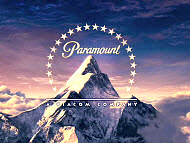
My Ratings: Moral rating: Average / Moviemaking quality: 4